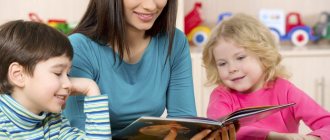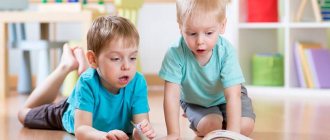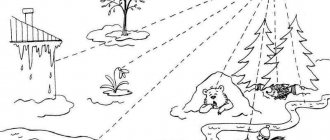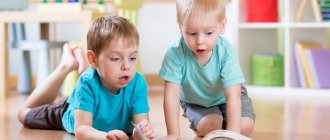Speech disorders with alalia manifest themselves:
- Difficulties in understanding spoken speech;
- Poverty of active vocabulary, slow and distorted development;
- Active use of gestures instead of words;
- Late formation of grammatical structure. The child does not agree on words in gender, number and case, confuses endings, etc.
- Deviations in the reproduction of the syllabic composition of a word;
- Difficulties in constructing a speech utterance, using simple narrative or incentive sentences.
In addition to speech disorders, there are non-speech symptoms that should alert parents and serve as a reason to contact a neurologist:
- General motor clumsiness, incoordination, slowness or disinhibition of movements;
- Increased difficulty developing fine motor skills;
- Instability of attention, difficulties in maintaining and switching it;
- Underdevelopment of higher mental functions such as memory, thinking;
- Disadvantages in the development of constructive praxis.
What to do if a child has delayed alalia?
Get tested. The child must be examined:
- speech therapist;
- speech pathologist;
- neurologist.
Causes of alalia:
- birth traumatic brain injury;
- asphyxia of newborns;
- intrauterine or early intravital infections with complications in the brain;
- depletion of the central nervous system in severe somatic diseases, rickets;
- unfavorable development conditions;
- smoking, alcoholism, drug addiction of parents.
Important to remember! The diagnosis of “alalia” can be made by a neurologist based on a brain examination (electroencephalography, computed tomography, magnetic resonance imaging)
Alalia classifications:
- motor alalia;
- sensory alalia;
- mixed alalia.
Motor alalia is a systemic underdevelopment of expressive speech due to the immaturity of linguistic operations in the process of generating speech utterances.
Example: Maxim O., 4 years old, diagnosed with motor alalia. The child demonstrates a fairly high level of understanding of addressed speech. The active vocabulary is severely limited. The child unifies words according to semantic features: boots - boots, sneakers - boots, etc. Verbal vocabulary is supported by gestures: the verbs “swim”, “dig”, “eat” are replaced either by gestures or by a gesture and the phrase “like this”. Difficulties in the use of grammatical forms of the plural and prepositional-case constructions are noted. Gross violations of the syllabic structure of the word were revealed: rearrangements of sounds and syllables “sepok - sand”, omissions of sounds and syllables “cow - cow” “irons - irons”. In his own speech, the child uses a simple sentence of 2-3 words, often grammatically unrelated.
Forms of motor alalia:
- afferent motor alalia;
- efferent motor alalia.
Afferent motor alalia manifests itself in difficulty in reproducing individual articulatory movements corresponding to certain speech sounds.
Example: Igor K., 3 years old, diagnosed with “motor alalia of the afferent type.” A neurologist diagnosed motor alalia in the child. The child understands speech at an everyday level and is guided by gesture cues. In his own speech he uses rare single vocalizations. Upon request, can reproduce a speech sound no more than 2 - 3 times. When asked again to reproduce the same sound after a certain period of time, the child finds it difficult to answer: remains silent/opens his mouth silently/produces a different sound.
Efferent motor alalia manifests itself in a violation of the linear sequence of the structure of words and sentences.
Example: Ivan S., 4 years old, diagnosed with “motor alalia of the efferent type.” Speech disorders in a child with efferent motor alalia manifest themselves in gross distortion of the syllabic structure of the word, “stuckness” and rearrangement of sounds and syllables: instead of “bye” Ivan says “dad”, instead of “Misha” - “mimi”, the word “kisa” is replaced by the word "sika".
Important to remember! A favorable prognosis for alalia is possible with timely diagnosis and early initiation of corrective work.
Sensory alalia is a disorder of speech understanding associated with insufficient functioning of the central part of the auditory analyzer. Children with sensory alalia do not develop phonemic awareness. This leads to the fact that children do not perceive the word as a whole; they hear, but do not understand the addressed speech.
Example: Sasha, 6 years old, diagnosed with sensory alalia. The girl has difficulty localizing a non-speech sound in space (bell, rattle). Sasha has difficulty understanding short one-step instructions and often focuses on one more significant word in the instructions: “Show the house” - he takes a toy house and tries to open and close the doors in it, “Give me a car - he rolls the car on the table.” In one’s own speech there is a large number of babbling words, among which sometimes individual words or fragments of them slip through. Words are replaced by syllables: “red – ka”, “yellow – jo”, “grapes – ve”, “orange – pe”.
Mixed alalia is a form of alalia in which both understanding and speech reproduction are impaired. Such variants of alalia are called “motor alalia with a sensory component”, “sensorimotor alalia”. Thus, the absence of clear kinesthetic sensations with defective sound pronunciation entails insufficient auditory discrimination of speech sounds that are similar in articulation and acoustics. This leads to difficulty filling the dictionary, incorrect use of prepositions and morphological elements.
Important to remember! Careful monitoring of the state of the child’s speech and an in-depth medical examination helps determine the optimal forms and directions of correctional and educational intervention.
Diagnostics
To diagnose motor alalia, it is necessary to examine the child by a pediatric otolaryngologist, neurologist, speech therapist, or psychologist.
When conducting a speech therapy examination of a child, considerable attention is paid to collecting a perinatal history and the characteristics of the patient’s early development. To diagnose motor alalia, it is necessary to assess the child’s desire to speak, determine the presence of difficulties in repeating what he heard, auditory perception, active use of facial expressions and gestures, perception and understanding of speech, and the presence of echolalia. In addition, the level of active and passive vocabulary, syllabic structure of words, pronunciation of sounds, grammatical structure of speech and phonemic perception are noted.
To assess the severity of brain damage, electroencephalography, echoencephalography, magnetic resonance imaging of the brain, and x-ray examination of the skull may be required. For differential diagnosis with sensory alalia and hearing loss, audiometry, otoscopy and some other methods of studying auditory function are used. Differential diagnosis with dysarthria, autism, mental retardation, and delayed speech development is required.
Symptoms of motor alalia:
- Poor active vocabulary, its slow and distorted development:
- limiting the vocabulary to the everyday level;
- difficulty in updating existing lexical units in one’s own speech;
- frequent lexical substitutions;
- stereotypical statements, speech cliches;
- difficulties in word formation and inflection.
- Later and peculiar formation of the grammatical structure:
- difficulties with nominal and verbal control, with coordination, and the use of numerical and generic endings;
- omitting prepositions and conjunctions.
- "telegraph style" (not in all cases)
- A peculiar development of phonetics:
- difficulties in forming fine articulatory movements;
- violation of the sequence and switchability of articulatory movements;
- difficulties in merging sounds in a word (syllable);
- the inconsistent nature of the sound design of the same words;
- Deviations in the development of the syllabic structure of words:
- reducing the number of syllables;
- rearrangements of sounds and syllables in a word;
- “stuck” on the previous syllable;
- Violation of the prosodic aspect of speech:
- unformed rhythmic structure of words and phrases;
- monotonous, inexpressive, poorly modulated speech;
- violations of tempo and rhythm;
- incorrect placement of logical stress (not always).
- Variability in speech understanding:
- situation-oriented understanding;
- difficulty understanding grammatical forms;
Games and exercises for sensorimotor correction
Games and exercises for sensorimotor correction
Every year in the city of Ufa the number of orphans and children left without parental care and placed in foster care is growing. All of them are accompanied by specialists from the “Family” center for psychological, medical and social support. Most of these children have complex psychological problems that their adoptive parents cannot cope with on their own. Many children have various developmental disabilities. The reasons for these deviations are parental alcoholism, pathology of pregnancy and childbirth, diseases suffered in early childhood, and unfavorable living conditions in a boarding school. These factors have a negative impact on the general health, intellectual and emotional development, and behavior of the child.
A child’s sensory development is the development of his perception and the formation of ideas about the external properties of objects: their shape, color, size, position in space, as well as smell and taste. The importance of sensory development in early and preschool childhood is very important. It is this age that is most favorable for improving the functioning of the senses and accumulating ideas about the world around us. A child's readiness for school largely depends on his sensory development. Research conducted by child psychologists has shown that a significant part of the difficulties that children encounter during primary education (especially in 1st grade) are associated with insufficient accuracy and flexibility of perception. There are five sensory systems through which a person experiences the world: vision, hearing, touch, smell, taste. In the development of sensory abilities, an important role is played by the development of sensory standards - generally accepted examples of the properties of objects. There are various games and exercises to develop sensory abilities. In this article we will look at games for the development of each sensory system.
Exercises for the vestibular system.
"Ring"
Children 6-7 years old, having gathered in a circle and choosing a driver, collect rings from their fingers at his expense. Suddenly the driver commands: “No middle!” - and the players continue to bust, skipping the middle finger. Then follows the command: “Without the little finger!” etc. The pace of the count speeds up, the one who made a mistake leaves the game.
"Ear and Nose"
This game can be played while sitting at a table. Everyone is asked to grab the tip of their nose with their left hand, and the left earlobe with their right hand. When the leader claps, you need to change the position of your hands, that is, grab your right earlobe with your left hand, and grab your nose with your right hand. At first, the intervals between claps are long, and then the leader increases the pace of the game, and the intervals between claps become smaller and smaller. The winner is the one who lasts the longest and does not get entangled in his hands, noses and ears.
"Ball Games"
All ball games are aimed at improving the vestibular system, you can use “edible - inedible”, “I know...”.
"Walking the Line"
Material: a line (strip) 3-4 centimeters wide in the shape of an ellipse, pasted or drawn on the floor. The large diameter of the ellipse must be at least 4 meters long.
Goal: coordination of movements, balance training. Consciously feel your own body, experience a state of inner peace through concentration. How to play: Children sit around an ellipse. They are far enough away from him so as not to touch him with their feet. The teacher walks along the line once, trying to draw the child’s attention to the placement of the entire foot along the line and to the naturalness of walking. The toes and heel are in line. In this example, the child understands the progress of the exercise. Then the teacher calls the children by name one by one and asks each one to start the exercise. Gradually all the children in the group take part in the exercise. By observing, the teacher notices the difficulties of individual children and can then intervene tactfully, expressing general wishes, for example, “We are trying to step exactly on the line.”
"Between two shores"
Material: we place two jump ropes next to each other, starting from a distance of 50 cm, gradually reducing the distance to 10 cm. The task
is to
walk between the lines, trying not to step on the edges.
"Stepping over the rope"
To play, you will need a rope that must be placed on the floor. Task: place your feet on both sides of the rope.
"On the socks"
How to play: Take a tambourine or drum and knock on it first quietly, then louder and finally very loudly. Children run on their toes. If the tambourine sounds quietly, you need to walk, the sound becomes louder - walk with long strides, even louder - run. The more often you change the rhythm, the more fun the game is.
"Football with a paper bag"
Inflate a paper bag. When playing football with them, children must match the force of the impact on the bag so that it does not tear.
"Snowballs"
a well-known game on the street, when the weather permits, but it is necessary to catch snowballs alternately with the right or left hand.
"Bubble"
Soap bubbles are used, you need to catch first with your left hand, then with your right.
It is advisable to use all types of games to develop fine motor skills, any kind of needlework, beadwork, drawing and coloring, collecting pyramids, getting objects, stringing large beads and rings; tear paper, roll “sausages” from plasticine; fasten buttons.
Exercises for the tactile system
"Catch the Pussy"
Purpose of the game: stimulation of tactile sensitivity, improvement of attention and reaction speed in the child. Progress of the game: The teacher touches different parts of the child’s body with a soft toy (pussy), and the child, with his eyes closed, determines where the pussy is. By analogy, you can use other objects to touch: a wet fish, a prickly hedgehog, etc.
"Wonderful bag"
Purpose of the game: stimulation of tactile sensitivity, training in differentiation of one's own sensations. Progress of the game: 1) Objects of different shapes, sizes, textures (toys, geometric shapes and bodies, plastic letters and numbers, etc.) are placed in an opaque bag. The child is asked to find the desired item by touch, without looking into the bag.
2) “Identify by touch” - the bag contains paired objects that differ in one feature (buttons large and small, rulers wide and narrow, etc.). You need to recognize the object by touch and name its characteristics: long - short, thick - thin, large - small, narrow - wide, etc.
3) “Find out the figure” - geometric figures identical to those in the bag are laid out on the table. The teacher shows any figure and asks the child to take the same one out of the bag.
"Handkerchief for a doll"
Purpose of the game: stimulation of tactile sensitivity, training in differentiation of one’s own sensations (identifying objects by the texture of the material, in this case, determining the type of fabric). Progress of the game: Children are offered three dolls in different scarves (silk, wool, knitted). Children take turns examining and feeling all the handkerchiefs. Then the handkerchiefs are removed and placed in a bag. Children find the right handkerchief for each doll by touch in the bag.
“Guess by touch what this object is made of”
Purpose of the game: stimulation of tactile sensitivity, training in differentiation of one's own sensations. Progress of the game: The child is asked to determine by touch what various objects are made of: a glass glass, a wooden block, an iron spatula, a plastic bottle, a fluffy toy, leather gloves, a rubber ball, a clay vase, etc. By analogy, you can use objects and materials of different textures and determine what they are: viscous, sticky, rough, velvety, smooth, fluffy, etc.
“Recognize an object by its outline”
The child is blindfolded and given a figure cut out of cardboard (it can be a bunny, a Christmas tree, a pyramid, a house, a fish, a bird). They ask what this item is. They remove the figure, untie their eyes and ask them to draw it from memory, compare the drawing with the outline, and trace the figure.
“Guess what the object is”
Various voluminous toys or small objects (rattle, ball, cube, comb, toothbrush, etc.) are laid out on the table, which are covered on top with a thin but dense and opaque napkin. The child is asked to use a napkin to identify objects by touch and name them.
"Find a Pair"
Material: plates covered with velvet, sandpaper, foil, corduroy, flannel. The child is asked, blindfolded, to find pairs of identical plates by touch.
"Find the box"
Material: matchboxes, covered with various materials on top: corduroy, wool, velvet, silk, paper, linoleum, etc. Pieces of material are also glued inside the drawers. The drawers are located separately. The child is asked to determine by touch which drawer is from which box.
"What's in the bag"
The child is offered small bags filled with peas, beans, beans or cereals: semolina, rice, buckwheat, etc. Going through the bags, he determines the filler and arranges these bags in a row as the size of the filler increases (for example, semolina, rice, buckwheat, peas, beans, beans).
“Guess the number” (letter)
A number (letter) is written on the child’s palm with the back of a pencil (or finger), which he determines with his eyes closed.
"What is this?"
The child closes his eyes. He is asked to touch the object with five fingers, but not to move them. Based on the texture, you need to determine the material (you can use cotton wool, fur, fabric, paper, leather, wood, plastic, metal).
"Collect a matryoshka doll"
Two players approach the table. They close their eyes. In front of them are two disassembled nesting dolls. On command, both begin to collect their own nesting dolls - who is faster.
"Read"
The players stand next to each other. The person standing behind writes letters, words, numbers, figures, objects on the partner’s back with his finger. The person in front guesses. Then the children change places.
"Cinderella"
Children (2-5 people) sit at the table. They are blindfolded. In front of each is a pile of seeds (peas, sunflower seeds, etc.). In a limited time, you should sort the seeds into piles.
"Guess what's inside"
Two people are playing. Each playing child has in his hands an opaque bag filled with small objects: checkers, pen caps, buttons, erasers, coins, nuts, etc. The teacher names the object, the players must quickly find it by touch and take it out with one hand, and hold the bag with the other. Who will do it faster?
If sensory sensitivity is impaired, you must use: - always warn the child that you are going to touch him, approach him only from the front; - remember that hugs can be more painful than comforting; - gradually introduce your child to different textures - prepare a box of materials for this (wool, silk, velvet paper, etc.); — teach your child independent actions that allow him to regulate sensitivity (for example, when combing his hair and washing).
If a child avoids touching unfamiliar objects, it is more advisable to use familiar toys (objects), you can, for example, hide them under the child’s clothes and look for them.
If a child has a constant need for tactile contact, children constantly hug, and do it very tightly, like to climb into tight places, then it is advisable for such children to use heavy blankets, sleeping bags, massage mats, rubbing with a hard washcloth, development of fine motor skills, work with materials of different textures and densities
Exercises for the visual system
"Fold the stripes"
Strips are cut, differing in length by 1 cm. The range of strips is from 3 cm to 16 cm. It is necessary to fold the strips into a ladder, but without touching each other.
“Find an item of the specified shape”
The child is asked to name models of geometric shapes, and then find pictures depicting objects similar in shape to a circle (square, oval, triangle, rectangle, rhombus).
“What figures does the machine consist of?”
Children must determine from the drawing what geometric shapes are included in the design of the machine, how many squares, circles, etc. it contains.
"Rug"
Goal: learn to place objects on a plane, consolidate knowledge of geometric shapes, numbers, names of primary colors, and additional ones. Equipment: a mat divided into 9 squares with adhesive tape in each, chips of your choice, which are located above the squares (butterflies of different colors, flowers of three colors, three pieces each, geometric shapes, numbers).
Variants of the game “Continue the Row”:
1) place blue flowers on the top strip, and green flowers on the bottom; 2) continue the row from top to bottom, bottom to top, right to left and vice versa.
"Name it by color"
Children say what color the butterfly is and where it sits, using the words “in”, “under”, “right”, “left”. At an older age, butterflies of a different color are added and the words “upper right corner”, “lower left corner” and more are added to speech.
"Finish the sentence"
In the center is .....; At the top is...; Below is...; On the right is ....; On the left is...
"Fill the Empty Cells"
Children find the missing numbers and put them in their place
"Find the treasure"
cover all the squares with butterflies (flowers, geometric shapes, numbers) and say that the treasure is under the pink butterfly, or in the upper right corner, or in the middle row in the second place from left to right, and so on.
"Name your neighbor"
place geometric shapes or numbers in all cells and ask them to name, for example, the neighbors of the number five on the right, left, or the neighbors of the circle at the top, bottom, right, left.
“Find an object of the same shape”
Children identify shapes in specific objects in their environment using geometric patterns.
There are geometric shapes on one table, objects on the other. For example, a circle and round-shaped objects (ball, plate, button, etc.), an oval and oval-shaped objects (egg, cucumber, acorn) .
“Which figure is the odd one out?”
The child is offered various sets of four geometric shapes. For example: three quadrangles and one triangle, three ovals and one circle, etc. It is required to identify an extra figure, explain the principle of exclusion and the principle of grouping.
"Make a whole from parts"
Make a design of 2-3 geometric shapes according to the model. Options: make a design from memory, according to description; create a geometric figure by selecting the necessary parts from the many proposed parts (8-9).
"Define correctly"
The child is asked to use the drawings to determine which geometric shapes the castle consists of.
"Visual dictation"
Children remember a pattern of 3-4 geometric shapes and put it together from memory.
“Determine the shape of the object”
Cards with images of objects are laid out in front of the child: a TV, a house, a table, a chandelier, a floor lamp, a bed, etc. The teacher suggests entering the name of the furniture, the image of which is similar to this geometric figure, into the corresponding slot of the punched card with cut out geometric shapes.
"What changed?"
The child is asked to look at several cards with letters (words, numbers, geometric shapes, etc.) and turn away (leave the room). The teacher removes (adds or swaps) cards. The child determines what has changed.
"Find the error"
The child is offered a card with incorrect spellings: words - one letter is written in a mirror way (missed, an extra one inserted); examples - an error was made in the calculation, the figure was written in a mirror, etc.; sentences - a word that is inappropriate in meaning (similar in spelling, etc.) is omitted or inserted.
"Find differences"
Children are asked to look at paired pictures with signs of differences (cards of letters and numbers with different spellings, different images of the same geometric shapes, etc.) and find these signs of differences and similarities.
"Overlay Images"
The child is presented with 3-5 contour images (objects, geometric shapes, letters, numbers) superimposed on each other. All images must be named.
"Hidden Images"
Present figures consisting of elements of letters and geometric shapes. You need to find all the hidden images.
"Paired Images"
Present two object images that are very similar in appearance to each other, but have up to 5-7 minor differences. You need to find these differences.
"Unfinished Images"
Present images with unfinished elements, for example, a bird without a beak, a fish without a tail, a flower without petals, a dress without a sleeve, a chair without a leg, etc. You need to name the missing details (or complete the drawing).
"Bitmaps"
Present images of objects, geometric shapes, letters, numbers made in the form of dots. It is necessary to name them.
"Inverted Images"
Present schematic images of objects, letters, numbers, rotated 180°. You need to name them.
"Cut Images"
Present parts of 2-3 images (for example, vegetables of different colors or different sizes, etc.). It is required to assemble whole images from these parts.
Exercises for the auditory system
“Distinguish between happy and sad music”
Children are given 2 cards. One of them is painted in bright, light, cheerful colors, corresponding to cheerful music, the other - in cold, gloomy, corresponding to sad music. After listening to the music, the children show a card that conventionally designates this type of music.
"Quiet and Loud"
Alternately quiet and loud music sounds; a child walks on tiptoes to quiet music, and stomps his feet to loud music. Options: -you can invite children to use their own voluntary movement options that correspond to the strength of the music; - use a large and small drum: the large one sounds loud, the small one - quiet;
- respond to the loud sound of a bass drum by playing loudly on a metallophone, and respond to quiet sounds by playing quietly on a metallophone; - draw wide and bright stripes for loud music, narrow and paler stripes for quiet music;
-find a toy, focusing on the loud or quiet sound of the bell.
“Guess what musical instrument sounds like”
Students are given cards with pictures of musical instruments or shown real musical instruments. A tape recording with the sound of one of them is turned on. The student who guesses the musical instrument by its timbre shows the correct card and names it.
"Far close"
The driver's eyes are closed. One of the children calls the name of the driver, sometimes close to him, sometimes at a distance. The driver must recognize the person who said his name by his voice.
"Be careful"
Purpose of the game: children learn to quickly and accurately respond to sound signals. How to play: Children march freely to the music. The teacher gives different commands, and the children imitate the movements of the named animal. For example, “stork” - stand on one leg, “frog” - sit down and squat, “birds” - run with arms outstretched, “hares” - jump, etc.
"Determine what you hear"
Various sounds can be heard from behind the screen: water pouring from glass to glass; rustling of thin and thick paper; cutting paper with scissors; a key falling on the table, a referee's whistle, an alarm clock ringing, etc. You need to determine what is heard. Noises can be recorded on the phone and reflect the noises of the surrounding world (cat purring, door creaking, car noise, snoring, rain, etc.) - the child needs to determine what the noise is.
"Noisy boxes"
Material: several boxes (you can use kinder surprises), which are filled with various materials (iron plugs, small wooden blocks, pebbles, coins, etc.) and when shaken, produce different noises (from quiet to loud). The child is asked to check the noises of all the boxes. Then the teacher asks to give a box with a quiet noise, and then with a loud noise. The child performs. Option: the child finds identical boxes.
"Listen and follow"
The teacher names several actions, but does not show them. Children must repeat these actions in the order in which they were named. For example: 1) turn your head to the right, turn your head forward, lower your head down, raise your head; 2) turn left, sit down, stand up, lower your head.
“What do you hear?”
At the teacher’s signal, the children’s attention is drawn from the door to the window, from the window to the door, and is asked to listen and remember what is happening there. Then each child must tell what happened.
Exercises for the olfactory system
Aromatherapy is a great way to practice with children who cannot smell certain odors or, on the contrary, are very sensitive to them. You and your baby will enjoy aromatic oils, candles, and diffusers. You can help your child learn to tolerate smells or use them to relax and calm down. Aromatherapy is a great way to stimulate, and depends largely on what scent you choose (for example, cinnamon is more likely to invigorate a child, while lavender is more likely to relax a child). If your baby is very sensitive to smells, encourage him to carry around a jar of scented oil that smells good to him (like peppermint) and smell it when other scents become difficult to tolerate.
Improving your sense of smell can be achieved by practicing in several areas. Any physical activity helps improve your sense of smell, as it improves overall blood circulation. But, above all, this applies to facial gymnastics.
Game exercise “Let's help Tuzik.”
Goal: to develop children’s ability to identify edible and inedible by smell.
Material: food products are placed in plastic disposable cups: bread, chocolate, fruit; toiletries: soap, perfume, toothpaste.
Progress of the game: invite the children, on behalf of Tuzik, who has lost his sense of smell and sight, to identify foods that are edible for him by smell.
Game exercise “Fruit or vegetable?”
Goal: to develop the ability to recognize the sign of smell and classify objects. Material: pieces of fruits and vegetables (banana, cucumber, apple, orange, lemon, onion, etc.) placed in plastic disposable cups.
Progress of the game: invite children to identify the foods in glasses by smell with their eyes closed and divide them into fruits and vegetables.
Game exercise “What did the cook prepare for lunch?”
This game exercise is best done during lunch.
Goal: development of sense of smell and taste.
Progress of the game: invite the children to determine the menu for today's lunch by smell. For example: cabbage soup, pea or fish soup, etc. Confirm the smell with the taste of the dish.
Game exercise “Boxes with smells”.
Goal: differentiation of odors using the sense of smell.
Material: two sets of 8 Kinder Surprise containers with small holes in each, filled with pungent-smelling substances (coffee, cloves, cinnamon, vanillin, zest, garlic, etc.).
Invite the children to smell all the containers of one set, then the teacher takes the containers out of the second set and invites them to smell and compare the smells of the two sets until a pair is found for each container. Invite children to do a similar exercise with their eyes closed (since in the absence of visual perception, the ability to perceive other senses is enhanced).
Non-speech symptoms with motor alalia:
- Neurological symptoms of varying severity;
- Motor clumsiness:
- incoordination;
- slowness/disinhibition of movements;
- decreased motor activity;
- lack of rhythm;
- violation of dynamic and static balance;
- difficulties with fine motor skills of the fingers.
- Instability of active attention: difficulties in its distribution and switching;
- Peculiarity of memory:
- narrowing of memory capacity;
- rapid fading of emerging traces;
- limited verbal auditory memory
- Lag in the development of verbal and logical thinking:
- lack of flexibility of thinking;
- insufficient dynamism in the assimilation of non-linguistic and linguistic patterns;
- Disadvantages of constructive praxis:
- inability to assemble cut pictures;
- difficulties in constructing from sticks;
- With motor alalia, the following may also be observed:
- Increased irritability;
- Tense state;
- Tendency to tears;
- Impulsive states;
- Touchiness.
Important to remember! The presence of several of the above symptoms in a child does not mean that he has motor alalia. To make a diagnosis, you need to consult a neurologist.
Manifestations of motor alalia in a child aged 4 years
Example: Alexey K., 4 years old. Conclusion: motor alalia. Late speech development – first words after 2 years. The active dictionary contains about 15-20 words: “dad,” “mom,” “baba,” “there,” “meow,” etc., and uses syllables, amorphous words, gestures, and facial expressions when communicating. Understanding speech is situational. Phrasal speech is not formed. An insufficiency of volume, accuracy and switchability of general and voluntary articulatory movements was revealed. Motor disinhibition is noted. Attention is unstable and exhausted.
Games to develop gross motor skills, sense of rhythm and balance
1. Play ball - any games where you need to throw, catch, or hit the ball with your hand or foot are suitable. 2. Turn the child upside down and hold him by the legs, waving him in the air. 3. Spin the child while holding his hands. 4. With kids - toss on your knees: “Over the bumps, over the bumps, into the hole - bang!” 5. Games based on the “Freeze - die” principle. For example, run and make faces until the command “freeze” is heard. After this, freeze and do not move until the command “die.” 6. Any variants of games where there are “start” and “stop” commands. For example, running a race to the corner of the house: “Ready, attention, march!” 7. Smear shaving foam on any surface with your palms. 8. Pop soap bubbles with your palms. 9. Jump rope. 10. Build “huts” from chairs, blankets, pillows, etc. and sit in them. 11. Crawl through a tunnel made of chairs. 12. Wrap the baby in a blanket like a roll. 13. Reaction games, when you need to slap your partner’s palm with your palm before he pulls his hand away. 14. "Rock, paper, scissors." 15. Stand like a stork on one leg (who can stand longer). 16. Play with balloons (toss, catch, throw over a fence, etc.) 17. Swing on a swing (a hammock is also suitable), merry-go-round, jump on a trampoline 18. Make snowmen, play snowballs, roll in the snow. 19. Train basic locomotor skills: walking, running, jumping, skipping, side steps. 20. Spin your child around in an office chair. 21. Walk like a tightrope walker on some narrow and long surface such as a gymnastic bench or beam. You can make a path on the floor from tape at home and walk along it, like on a narrow bridge over an abyss. 22. Ride a bike. The bicycle can be anything: it is important that there are pedals that you need to press with your feet in turn. It is important that the legs leave the ground. Therefore, a battery-powered children's car, which is driven by a remote control or a button, cannot replace the most ordinary bicycle. 23. Counting tables - rhythmic pronunciation of text combined with hand movement. 24. Poems with movements. 25. Clap your hands to the rhythm of the music. 26. Dance rhythmically to music, sing.
Speech symptoms with sensory alalia:
- Impaired understanding of spoken speech due to impaired phonemic hearing;
- Phonemic hearing impairment of varying degrees:
- complete indistinction of speech sounds (the child does not respond to the name, shows indifference to any non-speech and speech sounds);
- understanding of individual frequency words (the child understands individual everyday words, but does not understand them against the background of a general statement);
- following specific instructions given in a familiar situation (the child understands the statement within the context, but does not understand the meaning of grammatical structures);
- Difficulties in developing an active vocabulary;
- Gross violations of the syllabic structure of words:
- replacing sounds in a word;
- repetition of the previous syllable;
- omissions of sounds and parts of words;
- Violations of grammatical structure;
- In one’s own speech one observes:
- logorrhea;
- immediate or delayed echolalia;
- Phonetic disorders;
Non-speech symptoms with sensory alalia:
- Disorders of voluntary auditory attention:
- instability of auditory reactions;
- lack of auditory-speech differentiation;
- increased exhaustion of auditory attention.
- Auditory memory disorders:
- inferiority of auditory analysis;
- difficulties in mastering auditory synthesis;
- With sensory alalia, the following may also be observed:
- The phenomenon of hyperacusis (increased sensitivity to sounds);
- Behavioral difficulties;
- Insufficient contact;
- Features of the development of the emotional-volitional sphere;
- Secondary mental retardation.
Symptoms
In general, the child can speak. Communicates actively, sometimes too emotionally. However, sensory alalia affects the child’s critical assessment of his speech. Because of this, he may not even understand what he is talking about. Symptoms include:
- Although hearing is preserved, attention is unstable. There is an increase in sensitivity to a number of sounds - hyperacusis.
- A violation of phonemic speech perception also manifests itself - the brain does not process the signals entering it. Because of this, the child does not understand what he heard.
- It is very difficult to remember sounds.
- Signs of logorrhea, a tendency to create words and phrases that do not exist, may appear. It is also possible to mix syllables, words, phrases.
- An obsessive desire to repeat words and phrases heard, for example, from cartoons or advertising. The difficulty in detecting a symptom is that what the child says may seem like something meaningful. However, if the phrase changes, he will no longer be able to understand it.
Manifestations of sensory alalia in a 6-year-old child
Example: Anna T., 6 years old. Conclusion: sensory alalia. During the examination, motor disinhibition and restlessness are noted. Voluntary activity is not formed. Speech understanding is grossly impaired. The phenomenon of hyperacusis is observed. In one’s own speech there are fragments of interjections, words that are not a means of communication.
Important to remember! The most favorable prognosis for a diagnosis of alalia is possible with early detection of the problem, competent treatment and timely adequate correctional and pedagogical assistance.
Speech therapists at the “Easy to Speak” Speech Development Center adhere to a psycholinguistic approach when correcting alalia. Within the framework of this approach, and referring to famous Russian authors such as B.M. Grinshpun, S.N. Shakhovskaya, V.K. Vorobyova, N.S. Zhukova are developing corrective intervention programs for children with alalia.
Corrective work for motor alalia
Focused on overcoming not only speech, but also non-speech disorders in the child. The choice of speech therapy technique depends on the structure and severity of disturbances in motor alalia, the ratio of speech and non-speech disorders, communication characteristics, as well as the personal characteristics of the child.
Important to remember! At the Speech Development Center “Easy to Speak”, each child with motor alalia is prescribed his own program of correctional work.
In addition to classes with a speech therapist, children with motor alalia are recommended to:
- Observation by a neurologist;
- Classes with a psychologist/special psychologist;
- Consultations with a kinesiotherapist.
Important to remember! Drug treatment for motor alalia is selected only by the attending physician!
For children with motor alalia, activities such as:
- Logorhythmics;
- Adaptive physical education;
- Art therapy (fairytale therapy, sand therapy, puppet therapy, music therapy, etc.)
At the speech development center “It’s easy to speak,” a child with motor alalia is offered:
- Psychological, pedagogical and speech therapy examination;
- Drawing up a program of correctional and speech therapy work;
- Psychological and pedagogical family counseling;
- Classes with a speech therapist;
- Classes with a defectologist;
- Logorhythmic exercises;
- Art therapy classes.
The Center's teachers are proficient in various methods, technologies and techniques for speech therapy work with motor alalia; undergo additional training and advanced training, participate in specialized conferences and seminars.
Treatment of alalia in children
Treatment methods for sensory, motor and mixed forms of alalia in children depend on the severity of symptoms, the severity of the disease, and the presence or absence of signs of other disorders. Depending on the specific situation, doctors may prescribe drug therapy and physical therapy to stimulate adequate brain function.
In parallel, constant work is carried out with a psychologist and speech therapist, with regular attendance at classes and consolidation of the results at home. The training is aimed at developing fine motor skills, improving the pronunciation of specific sounds and individual words.
If necessary, the chosen treatment regimen is adjusted and supplemented with massage, physical therapy, and psychotherapy.









